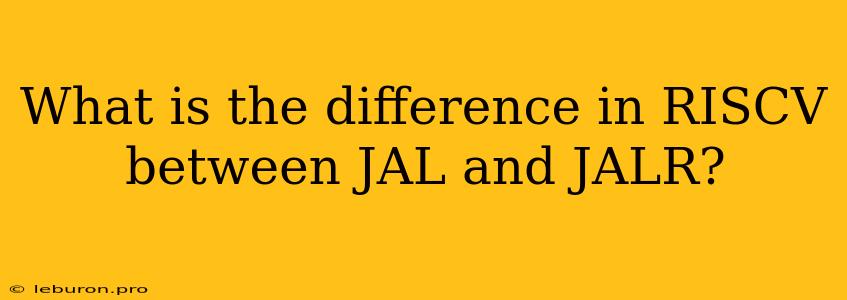The RISC-V instruction set architecture (ISA) is a modern, open-source alternative to traditional CPU architectures like x86 and ARM. Within this ISA, various instructions are used for program control and flow. Two such instructions, JAL (Jump and Link) and JALR (Jump and Link Register), are often used for function calls and subroutine jumps. While they appear similar in functionality, their underlying mechanics and use cases differ significantly. This article delves into the key differences between JAL and JALR in the RISC-V ISA, providing a comprehensive understanding of their roles in program execution.
Understanding the Purpose of JAL and JALR
Both JAL and JALR instructions are primarily employed for function calls and branching in RISC-V programs. Their essential function is to transfer program execution to a new location while storing the address of the instruction following the jump, enabling a return to the original execution flow later.
JAL: Unconditional Jump and Link
The JAL (Jump and Link) instruction is an unconditional jump that takes the program execution to a specific target address while simultaneously saving the address of the next instruction in the ra (return address) register. This register effectively stores the program's current position, allowing the program to return to this point after executing the target code.
JAL is often used for:
- Function Calls: When a program needs to execute a function, it uses JAL to jump to the function's starting address. The return address is saved in ra, allowing the program to return to the instruction following the call after the function has completed execution.
- Subroutine Calls: Similar to function calls, JAL can be used to call subroutines, which are smaller blocks of code that perform specific tasks.
JALR: Jump and Link Register
The JALR (Jump and Link Register) instruction is a conditional jump that takes the program execution to an address computed from the rs1 register and an immediate value. It also saves the return address in the ra register, similar to JAL.
JALR is often used for:
- Indirect Jumps: When the target address for the jump is not known beforehand, JALR can be used to compute the target address based on a register value. This allows for more dynamic jumps, enabling a program to change its behavior based on runtime conditions.
- Looping: In cases where the number of iterations in a loop is not known beforehand, JALR can be used to jump back to the beginning of the loop, providing a more flexible looping mechanism.
Key Differences Between JAL and JALR
-
Target Address Calculation:
- JAL: The target address for JAL is specified directly as an immediate value, which is a fixed value embedded within the instruction.
- JALR: The target address for JALR is calculated by adding the contents of the rs1 register to the immediate value. This allows for dynamic jumps based on register values.
-
Unconditional vs. Conditional Jump:
- JAL: JAL is an unconditional jump, meaning it will always jump to the specified target address.
- JALR: JALR is a conditional jump. The jump happens only if the rs1 register contains a non-zero value. This allows for conditional execution based on register values.
-
Immediate Value Range:
- JAL: JAL uses a 20-bit immediate value, allowing for jumps to addresses within a 2<sup>20</sup> byte range from the current instruction.
- JALR: JALR uses a 12-bit immediate value, limiting its jump range to 2<sup>12</sup> bytes.
-
Use Cases:
- JAL: JAL is mainly used for function calls and subroutine jumps, where the target address is known beforehand.
- JALR: JALR is used for indirect jumps, conditional jumps, and creating flexible loops, where the target address can be determined at runtime.
Illustrative Examples
To better illustrate the differences, let's consider some simple code examples:
Example 1: Function Call using JAL
.globl main
main:
jal my_function # Jump to the function my_function
# ... code after the function call ...
my_function:
# ... function code ...
ret # Return to the calling function
In this example, JAL is used to call the function my_function. The address of the instruction following the jal is saved in the ra register. When the function my_function finishes execution, the ret instruction, which is equivalent to jalr ra, 0, 0, is used to return to the calling function.
Example 2: Loop using JALR
.globl main
main:
li t0, 10 # Initialize counter to 10
loop:
# ... code to be executed in the loop ...
addi t0, t0, -1 # Decrement the counter
bltz t0, loop # Branch to loop if counter is less than zero
# ... code after the loop ...
Here, JALR is used for loop control. The bltz instruction compares the value in the t0 register with zero and performs a branch (effectively a jump) to the address specified by the loop label if the value is less than zero. This creates a loop that iterates until the counter reaches zero.
Conclusion
The JAL and JALR instructions are powerful tools for program control and function calls within the RISC-V ISA. By understanding their fundamental differences in how they calculate target addresses and handle conditions, developers can leverage them effectively to implement complex program flow and optimize code execution.
These instructions, along with other branching and control instructions, form the foundation for structured programming practices and efficient code organization within the RISC-V architecture. Understanding these fundamental differences is crucial for any developer working with RISC-V-based systems.
